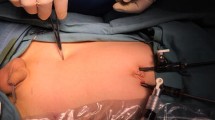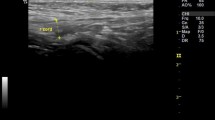Abstract
Purpose
We aimed to assess prospectively the feasibility and outcome of laparoscopic herniotomy (LH) in children in a tertiary center with limited resources.
Methods
Fifty-six children with unilateral pediatric inguinal hernia (PIH) were treated for an 18-month period. All cases were subjected to LH in a way similar to the classic open technique following exploration of the contralateral patent processus vaginalis (CPPV) without ligation of the sac. Exclusion criteria included prematurity, age <6 months, irreducible or recurrent hernia, and cases with internal ring diameter >2 cm. Operative findings, postoperative results, and complications were assessed.
Results
We have 56 cases presented with unilateral PIH, and they are aged between 6 months and 15 years. Thirty-two presented with Rt hernia including 12 associated with CPPV and 24 cases Lt hernia with 10 associated with CPPV. Two cases showed adhesions and 2 cases showed direct defects that were repaired in the same session. Hydrocele of the hernia sac was reported once. In the total of 78 hernias, the mean operative time was 20.5 min in unilateral cases and 42.5 min in bilateral cases. No conversion was reported. Postoperative pain lasts for a mean time of 11.2 h. Patients regained peristalsis by a mean of 7 h. Two cases developed wound infection and were treated conservatively. No case of recurrence, testicular atrophy, or hydrocele was reported in the mean follow-up period of 20.5 months.
Conclusions
Laparoscopic herniotomy is feasible and safe for PIH. It provides a superior tool to diagnose CPPV or rare hernias that can be managed in the same session with minimal postoperative complications reported even in developing countries. Laparoscopic herniotomy is proved to be beneficial for PIH since it provides an excellent view on the cord structures, and they can be guarded well during the procedure. Larger studies and longer follow-up are needed to support our encouraging results.


Similar content being viewed by others
References
Schier F, Danzer E, Bondartschuk M (2001) Incidence of contralateral patent processus vaginalis in children with inguinal hernia. J Pediatr Surg 36(10):1561–1563
Holcomb GW 3rd, Miller KA, Chaignaud BE, Shew SB, Ostlie DJ (2004) The parental perspective regarding the contralateral inguinal region in a child with a known unilateral inguinal hernia. J Pediatr Surg 39(3):480–482
Owings EP, Georgeson KE (2000) A new technique for laparoscopic exploration to find contralateral patent processus vaginalis. Surg Endosc 14(2):114–116
Chinnaswamy P, Malladi V, Jani KV, Parthasarthi R, Shetty RA, Kavalakat AJ, Prakash A (2005) Laparoscopic inguinal hernia repair in children. JSLS 9(4):393–398
Schier F, Montupet P, Esposito C (2002) Laparoscopic inguinal herniorrhaphy in children: a three-center experience with 933 repairs. J Pediatr Surg 37(3):395–397
Lau ST, Lee YH, Caty MG (2007) Current management of hernias and hydroceles. Semi Pediatr Surg 16(1):50–57
Levitt MA, Ferraraccio D, Arbesman MC, Brisseu GF, Caty MG, Glick PL (2002) Variability of inguinal hernia surgical techniques: a survey of North American Pediatric Surgeons. J Pediatr Surg 37(5):745–751
Schier F (2006) Laparoscopic inguinal hernia repair: a prospective personal series of 542 children. J Pediatr Surg 41(6):1081–1084
Shalaby R, Fawy M, Soliman S, Dorgham A (2006) A new simplified technique for needloscopic inguinal herniorrhaphy in children. J Pediatr Surg 41(4):863–867
Tsai YC, Wu CC, Yang SD (2007) Mini laparoscopic herniorrhaphy with hernia sac transaction in children and young adults: a preliminary report. Surg Endosc 21(9):1623–1625
Giseke S, Glass M, Tapadar P, Matthyssen I, Phillipe PA (2010) A true laparoscopic herniotomy in children: evaluation of long term outcome. J Laparoendosc Adv Surg Tech A 20(2):191–194
Yeung CK, Lee KH (2008) Inguinal herniotomy: laparoscopic assisted extraperitoneal technique. In: Bax KNA, Georgeson KE, Rothenberg SS, Valla JS, Yeung CK (eds) Endoscopic Surgery in Infants and Children. Berlin Heidelberg, Springer, pp 577–584
Niyogi A, Tahim AS, Sherwood WJ, De Caluwe D, Madden NP, Abel RM, Haddad MJ, Clarke SA (2010) A comparative study examining open inguinal herniotomy with and without hernioscopy to laparoscopic inguinal hernia repair in a pediatric population. Pediatr Surg Int 26(4):387–392
Mohta A, Jain N, Irniraya KP, Saluja SS, Sharma S, Gupta A (2003) Non-ligation of hernial sac during herniotomy: A prospective study. Pediatr Surg Int 19(6):451–452
Riquelme M, Aranda A, Riquelme QM (2010) Laparoscopic pediatric inguinal hernia repair: no ligation, just resection. J Laparoendosc Adv Surg Tech A 20(1):77–80
Valusek PA, Spilde TL, Ostlie DJ, St Peter SD, Morgan WM 3rd, Brock JW 3rd, Holcomb GW 3rd (2006) Laparoscopic evaluation for contralateral patent processus vaginalis in children with unilateral inguinal hernia. J Laparoendosc Adv Surg Tech A 16(6):650–653
Prasad R, Lovvorn HN 3rd, Wadie GM, Lobe TE (2003) Early experience with needloscopic inguinal herniorrhaphy in children. J Pediatr Surg 38(6):1055–1058
Tamaddon H, Phillips JD, Nakayama DK (2005) Laparoscopic evaluation of the contralateral groin in pediatric inguinal hernia patients: a comparison of 70—and 120-degree endoscopes. J Laparoendosc Adv Surg Tech A 15(6):653–660
Geisler DP, Jegathesan S, Parmley MC, McGee JM, Nolen MG, Broughan TA (2001) Laparoscopic exploration for the clinically undetected hernia in infancy and childhood. Am J Surg 182(6):693–696
Manoharan S, Samarakkody U, Kulkarni M, Blakelock R, Brown S (2005) Evidence-based change of practice in the management of unilateral inguinal hernia. J Pediatr Surg 40(7):1163–1166
Nixon RG, Pope JC 4th, Adams MC, Holcomb GW 3rd, Brock JW 3rd (2002) Laparoscopic variability of the internal inguinal ring: review of anatomical variation in children with and without a patent processus vaginalis. J Urol 167(4):1818–1820
Takehara H, Yakabe S, Kameoka K (2006) Laparoscopic percutaneous extraperitoneal closure for inguinal hernia in children: clinical outcome of 972 repairs done in 3 pediatric surgical institutions. J Pediatr Surg 41(12):1999–2003
Bharathi RS, Arora M, Baskaran V (2008) Pediatric inguinal hernia: laparoscopic versus open surgery. JSLS 12(3):277–281
Bax KNA, Van der Zee D (1999) Complications of laparoscopic surgery in children. In: Bax KNA, Georgeson KE, Najmaldin A, Valla JS (eds) Endoscopic Surgery in Children. Springer, Berlin, pp 491–492
Esposito C, Mattioli G, Monguzzi GL (2002) Complications and conversions of pediatric videosurgery: the Italian multicentric experience on 1689 procedures. Surg Endosc 16(5):795–798
Becmeur F, Philippe P, Schultz AL, Moog R, Grandadam S, Lieber A, Toledano D (2004) A continuous series of 96 laparoscopic inguinal hernia repairs in children by a new technique. Surg Endosc 18(10):1738–1741
Chan KL, Chan HY, Tam PK (2007) Towards a near zero recurrence rate in laparoscopic inguinal hernia repair for pediatric patients of all ages. J Pediatr Surg 42:1993–1997
Dutta S, Albanese C (2009) Transcutaneous laparoscopic hernia repair in children: a prospective review of 275 hernia repairs with minimum 2-year follow-up. Surg Endosc 23(1):103–107
Chen K, Xiang G, Wang H, Xiao F (2011) Towards a near-zero recurrence rate in laparoscopic inguinal hernia repair for pediatric patients. J Laparoendosc Adv Surg Tech A 21(5):445–448
Esposito C, Montinaro L, Alicchio F, Savanelli A, Armenise T, Settimi A (2010) Laparoscopic treatment of inguinal hernia in the first year of life. J Laparoendosc Adv Surg Tech A 20(5):473–476
Conflict of interest
Prof Dr Sherif Shehata, Dr Ashraf El Attar, Prof Dr Mohamed Attia, Dr AlHassan Hassan declares that they have no conflict of interest and nothing to disclose.
Author information
Authors and Affiliations
Corresponding author
Rights and permissions
About this article
Cite this article
Shehata, S.M.K., El Attar, A.A., Attia, M.A. et al. Laparoscopic herniotomy in children: prospective assessment of tertiary center experience in a developing country. Hernia 17, 229–234 (2013). https://doi.org/10.1007/s10029-012-1031-1
Received:
Accepted:
Published:
Issue Date:
DOI: https://doi.org/10.1007/s10029-012-1031-1




